一、加入 Spring:使用 Spring 整合 Hibernate 和 Struts2
1.1. 加入 jar 包
1.2. 配置 web.xml 文件
1.2.1 原来的配置:

1.2.2 添加配置:
<?xml version="1.0" encoding="UTF-8"?>
<web-app xmlns:xsi="http://www.w3.org/2001/XMLSchema-instance"
xmlns="http://java.sun.com/xml/ns/javaee"
xsi:schemaLocation="http://java.sun.com/xml/ns/javaee http://java.sun.com/xml/ns/javaee/web-app_3_0.xsd"
id="WebApp_ID" version="3.0">
<!-- 配置启动 Ioc 容器的 Listener -->
<context-param>
<param-name>contextConfigLocation</param-name>
<!-- 配置文件的位置 -->
<param-value>classpath:applicationContext*.xml</param-value>
</context-param>
<listener>
<listener-class>org.springframework.web.context.ContextLoaderListener</listener-class>
</listener>
</web-app>
1.3. 加入 Spring 的配置文件
1.3.1 新建 conf 源码包
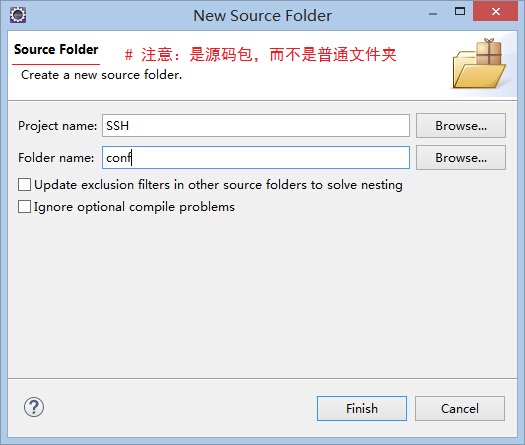
1.3.2 编辑 Spring 的配置文件 applicationContext.xml
conf/applicationContext.xml:
<?xml version="1.0" encoding="UTF-8"?>
<beans xmlns="http://www.springframework.org/schema/beans"
xmlns:xsi="http://www.w3.org/2001/XMLSchema-instance"
xmlns:aop="http://www.springframework.org/schema/aop"
xmlns:context="http://www.springframework.org/schema/context"
xmlns:tx="http://www.springframework.org/schema/tx"
xsi:schemaLocation="http://www.springframework.org/schema/beans http://www.springframework.org/schema/beans/spring-beans.xsd
http://www.springframework.org/schema/aop http://www.springframework.org/schema/aop/spring-aop-4.0.xsd
http://www.springframework.org/schema/context http://www.springframework.org/schema/context/spring-context-4.0.xsd
http://www.springframework.org/schema/tx http://www.springframework.org/schema/tx/spring-tx-4.0.xsd">
</beans>
二、加入 Hibernate
2.1. 加入 jar 包
2.2. 在类路径下加入 hibernate.cfg.xml 文件,在其中配置 Hibernate 的基本属性
conf/hibernate.cfg.xml:
<?xml version="1.0" encoding="UTF-8"?>
<!DOCTYPE hibernate-configuration PUBLIC
"-//Hibernate/Hibernate Configuration DTD 3.0//EN"
"http://hibernate.sourceforge.net/hibernate-configuration-3.0.dtd">
<hibernate-configuration>
<session-factory>
<!-- 配置 hibernate 的基本属性 -->
<!-- 方言 -->
<property name="hibernate.dialect">org.hibernate.dialect.MySQL5InnoDBDialect</property>
<!-- 是否显示及格式化 SQL -->
<property name="hibernate.show_sql">true</property>
<property name="hibernate.format_sql">true</property>
<!-- 生成数据表的策略 -->
<property name="hibernate.hbm2ddl.auto">update</property>
<!-- 二级缓存相关 -->
</session-factory>
</hibernate-configuration>
2.3. 建立持久化类和其对应的 .hbm.xml 文件
2.3.1 创建实体类 Department
public class Department {
private Integer id;
private String departmentName;
public Integer getId() {
return id;
}
public void setId(Integer id) {
this.id = id;
}
public String getDepartmentName() {
return departmentName;
}
public void setDepartmentName(String departmentName) {
this.departmentName = departmentName;
}
public Department() {}
public Department(Integer id, String departmentName) {
this.id = id;
this.departmentName = departmentName;
}
}
2.3.2 创建实体类 Employee
public class Employee {
private Integer id;
private String lastName; // 一被创建,则不能修改
private String email;
private Date birth; // 从前端传入的是 String 类型,所以需要转换
private Date createTime; // 一被创建,则不能修改
private Department department; // 单向多对一的关联关系
public Integer getId() {
return id;
}
public void setId(Integer id) {
this.id = id;
}
public String getLastName() {
return lastName;
}
public void setLastName(String lastName) {
this.lastName = lastName;
}
public String getEmail() {
return email;
}
public void setEmail(String email) {
this.email = email;
}
public Date getBirth() {
return birth;
}
public void setBirth(Date birth) {
this.birth = birth;
}
public Date getCreateTime() {
return createTime;
}
public void setCreateTime(Date createTime) {
this.createTime = createTime;
}
public Department getDepartment() {
return department;
}
public void setDepartment(Department department) {
this.department = department;
}
public Employee() {}
public Employee(Integer id, String lastName, String email, Date birth,
Date createTime, Department department) {
this.id = id;
this.lastName = lastName;
this.email = email;
this.birth = birth;
this.createTime = createTime;
this.department = department;
}
}
2.3.3 创建映射文件 Department.hbm.xml
<?xml version="1.0"?>
<!DOCTYPE hibernate-mapping PUBLIC "-//Hibernate/Hibernate Mapping DTD 3.0//EN"
"http://hibernate.sourceforge.net/hibernate-mapping-3.0.dtd">
<!-- Generated 2014-7-22 11:21:48 by Hibernate Tools 3.4.0.CR1 -->
<hibernate-mapping>
<class name="com.johnnie.ssh.entities.Department" table="SSH_DEPARTMENT">
<id name="id" type="java.lang.Integer">
<column name="ID" />
<generator class="native" />
</id>
<property name="departmentName" type="java.lang.String">
<column name="DEPARTMENT_NAME" />
</property>
</class>
</hibernate-mapping>
2.3.4 创建映射文件 Employee.hbm.xml
<?xml version="1.0"?>
<!DOCTYPE hibernate-mapping PUBLIC "-//Hibernate/Hibernate Mapping DTD 3.0//EN"
"http://hibernate.sourceforge.net/hibernate-mapping-3.0.dtd">
<!-- Generated 2014-7-22 11:21:48 by Hibernate Tools 3.4.0.CR1 -->
<hibernate-mapping>
<class name="com.johnnie.ssh.entities.Employee" table="SSH_EMPLOYEE">
<id name="id" type="java.lang.Integer">
<column name="ID" />
<generator class="native" />
</id>
<property name="lastName" type="java.lang.String">
<column name="LAST_NAME" />
</property>
<property name="email" type="java.lang.String">
<column name="EMAIL" />
</property>
<property name="birth" type="java.util.Date">
<column name="BIRTH" />
</property>
<property name="createTime" type="java.util.Date">
<column name="CREATE_TIME" />
</property>
<!-- 映射单向 n-1 的关联关系 -->
<many-to-one name="department" class="com.johnnie.ssh.entities.Department">
<column name="DEPARTMENT_ID" />
</many-to-one>
</class>
</hibernate-mapping>
结构图:
2.4. Spring 整合 Hibernate
2.4.1 加入 c3p0 和 MYSQL 的驱动
2.4.2 新建数据库 ssh
2.4.3 加入数据库配置文件 db.properties
[conf/db.properties]
# MySQL 的基本配置
jdbc.user=root
jdbc.password=root
jdbc.driverClass=com.mysql.jdbc.Driver
jdbc.jdbcUrl=jdbc:mysql:///ssh
# 配置 c3p0
jdbc.initPoolSize=5
jdbc.maxPoolSize=10
# ...
注:user 和 password 的值请改为自己 Mysql 配置时的值
2.4.2 修改 Spring 的配置文件 applicationContext.xml:数据源、SessionFactory、声明式事务
<?xml version="1.0" encoding="UTF-8"?>
<beans xmlns="http://www.springframework.org/schema/beans"
xmlns:xsi="http://www.w3.org/2001/XMLSchema-instance" xmlns:aop="http://www.springframework.org/schema/aop"
xmlns:context="http://www.springframework.org/schema/context" xmlns:tx="http://www.springframework.org/schema/tx"
xsi:schemaLocation="http://www.springframework.org/schema/beans http://www.springframework.org/schema/beans/spring-beans.xsd
http://www.springframework.org/schema/aop http://www.springframework.org/schema/aop/spring-aop-4.0.xsd
http://www.springframework.org/schema/context http://www.springframework.org/schema/context/spring-context-4.0.xsd
http://www.springframework.org/schema/tx http://www.springframework.org/schema/tx/spring-tx-4.0.xsd">
<!-- 导入资源文件 -->
<context:property-placeholder location="classpath:db.properties" />
<!-- 配置 C3P0 数据源 -->
<bean id="dataSource" class="com.mchange.v2.c3p0.ComboPooledDataSource">
<property name="user" value="${jdbc.user}"></property>
<property name="password" value="${jdbc.password}"></property>
<property name="driverClass" value="${jdbc.driverClass}"></property>
<property name="jdbcUrl" value="${jdbc.jdbcUrl}"></property>
<property name="initialPoolSize" value="${jdbc.initPoolSize}"></property>
<property name="maxPoolSize" value="${jdbc.maxPoolSize}"></property>
</bean>
<!-- 配置 SessionFactory -->
<bean id="sessionFactory"
class="org.springframework.orm.hibernate4.LocalSessionFactoryBean">
<property name="dataSource" ref="dataSource"></property>
<property name="configLocation" value="classpath:hibernate.cfg.xml"></property>
<property name="mappingLocations" value="classpath:com/johnnie/ssh/entities/*.hbm.xml"></property>
</bean>
<!-- 配置 Spring 的声明式事务 -->
<!-- 1. 配置 hibernate 的事务管理器 -->
<bean id="transactionManager"
class="org.springframework.orm.hibernate4.HibernateTransactionManager">
<property name="sessionFactory" ref="sessionFactory"></property>
</bean>
<!-- 2. 配置事务属性 -->
<tx:advice id="txAdvice" transaction-manager="transactionManager">
<tx:attributes>
<tx:method name="get*" read-only="true" />
<tx:method name="lastNameIsValid" read-only="true" />
<tx:method name="*" />
</tx:attributes>
</tx:advice>
<!-- 3. 配置事务切入点, 再把事务属性和事务切入点关联起来 -->
<aop:config>
<aop:pointcut expression="execution(* com.johnnie.ssh.service.*.*(..))"
id="txPointcut" />
<aop:advisor advice-ref="txAdvice" pointcut-ref="txPointcut" />
</aop:config>
</beans>
2.4.3 新建 com.johnnie.ssh.service 包,存放所有的服务
2.5. 启动项目
运行项目,这时会看到原本是空的 ssh 数据库下生成了对应的数据表,如下:
三、加入 Struts2
3.1 加入 jar:若有重复的 jar,则删除较低版本的 jar
3.2 在 web.xml 文件中配置 Struts2 的 Filter
[web.xml]
<?xml version="1.0" encoding="UTF-8"?>
<web-app xmlns:xsi="http://www.w3.org/2001/XMLSchema-instance"
xmlns="http://java.sun.com/xml/ns/javaee"
xsi:schemaLocation="http://java.sun.com/xml/ns/javaee http://java.sun.com/xml/ns/javaee/web-app_3_0.xsd"
id="WebApp_ID" version="3.0">
<!-- 配置启动 IOC 容器的 Listener -->
<context-param>
<param-name>contextConfigLocation</param-name>
<!-- 配置文件的位置 -->
<param-value>classpath:applicationContext*.xml</param-value>
</context-param>
<listener>
<listener-class>org.springframework.web.context.ContextLoaderListener</listener-class>
</listener>
<!-- 配置 Struts2 的 Filter -->
<filter>
<filter-name>struts2</filter-name>
<filter-class>org.apache.struts2.dispatcher.ng.filter.StrutsPrepareAndExecuteFilter</filter-class>
</filter>
<filter-mapping>
<filter-name>struts2</filter-name>
<url-pattern>/*</url-pattern>
</filter-mapping>
</web-app>
3.3 加入 Struts2 的配置文件 strutsx.ml
[conf/struts.xml]
<?xml version="1.0" encoding="UTF-8" ?>
<!DOCTYPE struts PUBLIC
"-//Apache Software Foundation//DTD Struts Configuration 2.3//EN"
"http://struts.apache.org/dtds/struts-2.3.dtd">
<struts>
<constant name="struts.enable.DynamicMethodInvocation" value="false" />
<constant name="struts.devMode" value="true" />
<package name="default" namespace="/" extends="struts-default">
</package>
</struts>
3.4 Spring 整合 Struts2
3.4.1 加入 Struts2 的 Spring 插件 jar
3.4.2 在 Spring 的配置文件中正常配置 Action:注意 Action 的 scope 为 prototype
在 conf 下新建 applicationContext-beans.xml 文件,代码如下:
[conf/applicationContext-beans.xml]
<?xml version="1.0" encoding="UTF-8"?>
<beans xmlns="http://www.springframework.org/schema/beans"
xmlns:xsi="http://www.w3.org/2001/XMLSchema-instance"
xsi:schemaLocation="http://www.springframework.org/schema/beans http://www.springframework.org/schema/beans/spring-beans.xsd">
<!-- 配置 Action,注意 Action 的 scope 为 prototype -->
<bean id="employeeAction" class="com.johnnie.ssh.actions.EmployeeAction"
scope="prototype">
</bean>
</beans>
3.4.3 在 Struts2 的配置文件中配置 Action 时,class 属性指向该 Action 在 IOC 中的 id
[conf/struts.xml]
<?xml version="1.0" encoding="UTF-8" ?>
<!DOCTYPE struts PUBLIC
"-//Apache Software Foundation//DTD Struts Configuration 2.3//EN"
"http://struts.apache.org/dtds/struts-2.3.dtd">
<struts>
<constant name="struts.enable.DynamicMethodInvocation" value="false" />
<constant name="struts.devMode" value="true" />
<package name="default" namespace="/" extends="struts-default">
<!-- 配置 action -->
<!-- class 属性指向该 Action 在 IOC 中的 id,即 applicationContext-beans.xml 中配置的 id -->
<action name="emp-*" class="employeeAction" method="{1}">
</action>
</package>
</struts>
至此,SSH框架是正常搭建完毕了。接下来就是实现一些简单的功能。
四、完成功能:查询所有员工信息
4.1 初始化数据
4.1.1 ssh_department 表加入几条初始数据:
4.1.2 ssh_employee 表加入数据:
4.2 index.jsp
[WebContent/index.jsp]
<%@ page language="java" contentType="text/html; charset=UTF-8"
pageEncoding="UTF-8"%>
<!DOCTYPE html PUBLIC "-//W3C//DTD HTML 4.01 Transitional//EN" "http://www.w3.org/TR/html4/loose.dtd">
<html>
<head>
<meta http-equiv="Content-Type" content="text/html; charset=UTF-8">
<title>index</title>
</head>
<body>
<!-- 显示所有的 Employee 信息 -->
<a href="emp-list">List All Employees</a>
</body>
</html>
4.3 EmployeeDao.java
新建 com.johnnie.ssh.dao 包,并在该包下新建 EmployeeDao 文件:
public class EmployeeDao {
private SessionFactory sessionFactory;
public void setSessionFactory(SessionFactory sessionFactory) {
this.sessionFactory = sessionFactory;
}
public Session getSession () {
return this.sessionFactory.getCurrentSession();
}
public List<Employee> getAll(){
// 若在 Dao 中只查询 Employee 的信息,而 Employee 和 Department 还是
// 使用懒加载,页面上还需要显示员工部门信息,那么此时会出现懒加载异常
// 解决办法:
// 1.关闭懒加载 在 Employee.hbm.xml 的 many-to-one 中关闭懒加载 lazy = false-->不推荐
// 2.获取 Employee 时使用迫切左外连接同时初始化其关联的 Department 对象-->推荐
// 3.使用 OpenSessionInViewFilter
String hql = "FROM Employee e LEFT OUTER JOIN FETCH e.department";
return getSession().createQuery(hql).list();
}
}
4.4 EmployeeService.java
在 com.johnnie.ssh.service 包下新建 EmployeeService 文件:
public class EmployeeService {
private EmployeeDao employeeDao;
public void setEmployeeDao(EmployeeDao employeeDao) {
this.employeeDao = employeeDao;
}
public List<Employee> getAll(){
return this.employeeDao.getAll();
}
}
4.5 EmployeeAction.java
新建 com.johnnie.ssh.actions 包,并在该包下新建 EmployeeAction 文件
[EmployeeAction]
public class EmployeeAction extends ActionSupport implements RequestAware {
private static final long serialVersionUID = 1L;
private EmployeeService employeeService;
public void setEmployeeService(EmployeeService employeeService) {
this.employeeService = employeeService;
}
public String list () {
request.put("employees", employeeService.getAll());
return "list";
}
private Map<String, Object> request;
@Override
public void setRequest(Map<String, Object> request) {
this.request = request;
}
}
4.6 配置 applicationContext-beans.xml:
<?xml version="1.0" encoding="UTF-8"?>
<beans xmlns="http://www.springframework.org/schema/beans"
xmlns:xsi="http://www.w3.org/2001/XMLSchema-instance"
xsi:schemaLocation="http://www.springframework.org/schema/beans http://www.springframework.org/schema/beans/spring-beans.xsd">
<bean id="employeeDao" class="com.johnnie.ssh.dao.EmployeeDao">
<property name="sessionFactory" ref="sessionFactory"></property>
</bean>
<bean id="employeeService" class="com.johnnie.ssh.service.EmployeeService">
<property name="employeeDao" ref="employeeDao"></property>
</bean>
<!-- 配置 Action,注意 Action 的 scope 为 prototype -->
<bean id="employeeAction" class="com.johnnie.ssh.actions.EmployeeAction"
scope="prototype">
<property name="employeeService" ref="employeeService"></property>
</bean>
</beans>
4.7 配置 struts.xml:
<?xml version="1.0" encoding="UTF-8" ?>
<!DOCTYPE struts PUBLIC
"-//Apache Software Foundation//DTD Struts Configuration 2.3//EN"
"http://struts.apache.org/dtds/struts-2.3.dtd">
<struts>
<constant name="struts.enable.DynamicMethodInvocation" value="false" />
<constant name="struts.devMode" value="true" />
<package name="default" namespace="/" extends="struts-default">
<!-- 配置 action -->
<!-- class 属性指向该 Action 在 IOC 中的 id,即 applicationContext-beans.xml 中配置的 id -->
<action name="emp-*" class="employeeAction" method="{1}">
<result name="list">/WEB-INF/views/emp-list.jsp</result>
</action>
</package>
</struts>
4.8 编辑 emp-list.jsp 文件:
WebContent/views/emp-list.jsp:
<%@ page language="java" contentType="text/html; charset=UTF-8"
pageEncoding="UTF-8"%>
<%@ taglib prefix="s" uri="/struts-tags" %>
<!DOCTYPE html PUBLIC "-//W3C//DTD HTML 4.01 Transitional//EN" "http://www.w3.org/TR/html4/loose.dtd">
<html>
<head>
<meta http-equiv="Content-Type" content="text/html; charset=UTF-8">
<title>emp-list</title>
</head>
<body>
<h4>Employee List Page</h4>
<s:if test="#request.employees == null || #request.employees.size() == 0">
没有任何员工信息
</s:if>
<s:else>
<table border="1" cellpadding="10" cellspacing="0">
<tr>
<td>ID</td>
<td>LAST_NAME</td>
<td>EMAIL</td>
<td>BIRTH</td>
<td>CREATE_TIME</td>
<td>DEPT</td>
</tr>
<s:iterator value="#request.employees">
<tr>
<td>${id }</td>
<td>${lastName }</td>
<td>${email }</td>
<td>${birth }</td>
<td>${createTime }</td>
<td>${department.departmentName }</td>
</tr>
</s:iterator>
</table>
</s:else>
</body>
</html>
4.10 运行项目:
结果如下:
4.10.1 index.jsp:
4.10.2 查看所有员工信息:
4.10.3 控制台 SQL 语句输出:
前往 bascker/javaworld 获取更多 Java 知识








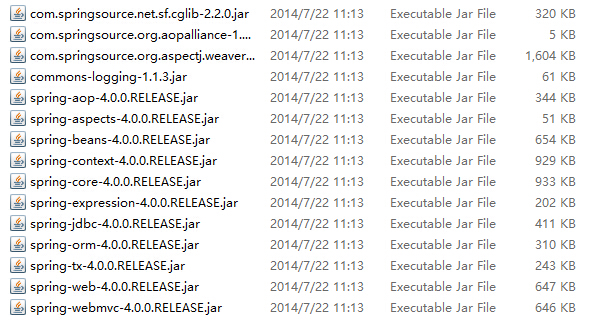

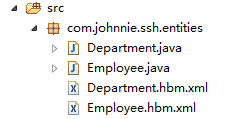

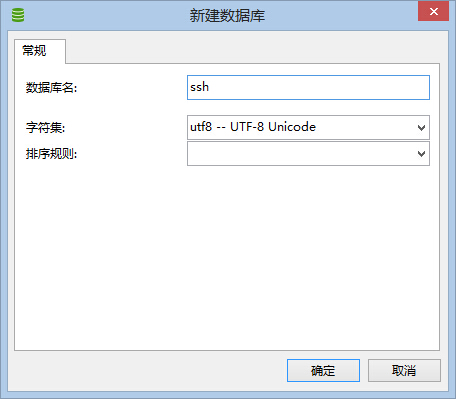
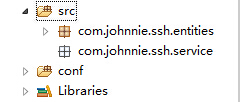
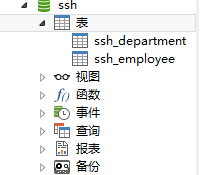






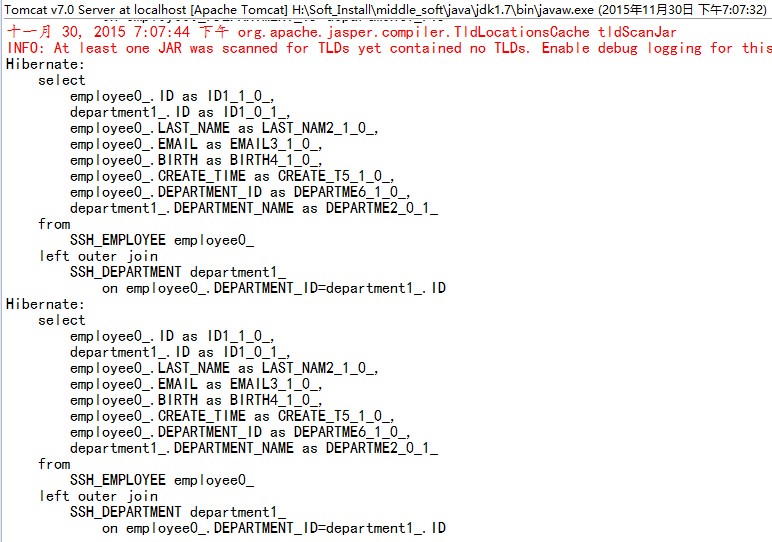














 249
249











 被折叠的 条评论
为什么被折叠?
被折叠的 条评论
为什么被折叠?








